A bedding accessory designed to enhance the comfort and support of a mattress, specifically sized to fit a full extra-long bed, is the subject of this exploration. This item is generally constructed from materials such as memory foam, latex, down alternatives, or wool and placed directly on top of a corresponding mattress. This configuration provides an additional layer of cushioning or firmness.
The addition of such an item can provide several benefits, including improved sleep quality through pressure relief and spinal alignment. It may also extend the lifespan of an existing mattress by absorbing wear and tear. These items offer a cost-effective alternative to replacing an entire mattress. Historically, similar bedding enhancements were utilized to increase the comfort of less sophisticated sleeping surfaces.
The subsequent sections will delve into the specifics of selecting the appropriate material, understanding available thicknesses, evaluating density, and considering the impact on temperature regulation. Furthermore, the impact of such bedding on overall sleep quality and potential health benefits will be addressed.
Guidance for Selecting a Suitable Bedding Enhancement for Full Extra-Long Mattresses
The following considerations are crucial when selecting a bedding enhancement intended for use with a full extra-long mattress. Careful assessment of individual needs and preferences is paramount for optimal satisfaction.
Tip 1: Evaluate Material Composition: Different materials offer varying degrees of support and temperature regulation. Memory foam conforms to the body, while latex provides a more responsive feel. Down alternatives and wool offer breathability and temperature control.
Tip 2: Determine Desired Thickness: The thickness of the bedding enhancement directly impacts the level of cushioning and support provided. Thicker options offer greater pressure relief, while thinner profiles may provide a subtle enhancement.
Tip 3: Assess Density: Density refers to the weight of the material per unit volume. Higher density materials generally offer greater durability and support. Low-density options may compress more quickly and offer less longevity.
Tip 4: Consider Temperature Regulation: Some materials retain more heat than others. Individuals who sleep hot should prioritize breathable materials such as latex, wool, or down alternatives designed for cooling.
Tip 5: Verify Dimensions: Ensure that the selected bedding enhancement accurately matches the dimensions of a full extra-long mattress to avoid overhang or insufficient coverage. Precise fit is essential for optimal comfort and performance.
Tip 6: Read Reviews and Research Brands: Due diligence in researching different brands and reading customer reviews can provide valuable insights into product quality, durability, and customer satisfaction.
Tip 7: Check Warranty and Return Policies: Prior to purchase, verify the manufacturer’s warranty and return policies. This will provide recourse in the event of manufacturing defects or dissatisfaction with the product.
Selecting a bedding enhancement for a full extra-long mattress requires careful consideration of material, thickness, density, and temperature regulation. Prioritizing individual needs and preferences will ensure a comfortable and supportive sleep environment.
The next section will provide details on cleaning, maintenance and care.
1. Dimensions
The dimensional accuracy of a mattress topper designed for a full extra-long mattress is paramount to its effective function and overall user satisfaction. The designation “full XL” defines a specific rectangular area, typically measuring 54 inches in width and 80 inches in length. A deviation from these measurements will result in either an insufficient surface coverage, leaving portions of the mattress unprotected, or an overhanging edge, potentially causing discomfort and accelerated wear of the topper itself. For example, a topper intended for a standard full-sized mattress (54 inches by 75 inches) will not adequately cover a full XL bed, leading to uneven support and a compromised sleeping surface.
The consequences of inaccurate dimensions extend beyond mere discomfort. A poorly fitting topper can bunch up, creating pressure points that disrupt sleep. Furthermore, if the topper is too small, it may shift during the night, requiring frequent readjustment. Conversely, an oversized topper can be a tripping hazard and may interfere with the proper fit of fitted sheets. Within commercial settings, such as dormitories or extended-stay hotels that frequently utilize full XL mattresses, ensuring correct dimensions is critical for consistent guest comfort and to avoid potential liability issues related to falls or injuries.
In summary, the precise adherence to the “full XL” dimensional specifications is not merely a matter of aesthetics, but a functional imperative. The correct dimensions guarantee proper fit, even support, and optimal comfort, directly influencing sleep quality and the longevity of both the topper and the mattress beneath. Potential challenges associated with inaccurate dimensions include discomfort, disrupted sleep, and potential safety hazards, underscoring the importance of verifying measurements prior to purchase and installation.
2. Material Density
Material density, in the context of a “mattress topper full xl,” is a critical attribute influencing its support, durability, and overall performance. Density refers to the mass of the material per unit volume, typically expressed in pounds per cubic foot (lbs/ft). Higher density materials generally offer greater resistance to compression and deformation, leading to enhanced support and longevity. Conversely, lower density materials tend to compress more easily, resulting in reduced support and a shorter lifespan. For example, a memory foam topper with a density of 5 lbs/ft will provide significantly more support and resist indentation better than one with a density of 3 lbs/ft.
The practical significance of material density is evident in the topper’s ability to distribute weight evenly and alleviate pressure points. A high-density topper can effectively contour to the body, providing targeted support to areas such as the shoulders and hips. This is particularly beneficial for individuals with back pain or other musculoskeletal conditions. Furthermore, density plays a vital role in preventing the topper from flattening or losing its shape over time. Regular use can cause lower density materials to compress permanently, diminishing their support capabilities and necessitating premature replacement. Consider a scenario where two identical full XL memory foam toppers are placed on beds. One, with high density, maintains its shape and support for several years, while the other, with low density, quickly develops impressions and loses its ability to provide adequate cushioning.
In summary, the material density of a “mattress topper full xl” directly impacts its support characteristics, durability, and long-term performance. Selecting a topper with an appropriate density, aligned with individual needs and preferences, is crucial for maximizing comfort and ensuring a worthwhile investment. While higher density materials may come at a premium, the enhanced support and extended lifespan often justify the increased cost. Understanding the implications of density enables informed decision-making and contributes to improved sleep quality.
3. Thickness Options
Thickness options for a mattress topper designed for a full extra-long bed are a primary determinant of the level of comfort and support provided. The measured dimension, typically ranging from one to four inches, directly influences the extent to which the topper modifies the feel of the underlying mattress. A thinner profile, such as a one-inch topper, provides a subtle layer of cushioning, suitable for individuals seeking minimal change or primarily aiming to protect the mattress. Conversely, a thicker profile, such as a four-inch topper, introduces a significant alteration, often employed to soften a firm mattress or enhance pressure relief. For instance, a college student residing in a dormitory with a standard, often rigid, full XL mattress may opt for a thicker topper to alleviate discomfort and improve sleep quality.
The selection of an appropriate thickness is contingent upon several factors, including individual preferences, body weight, and existing mattress condition. A heavier individual may require a thicker topper to prevent bottoming out, ensuring adequate support and spinal alignment. Furthermore, a mattress with significant sagging or indentations may necessitate a thicker topper to compensate for the compromised support structure. The impact of thickness extends beyond comfort; it can also influence temperature regulation. Thicker toppers, particularly those made of memory foam, may trap more heat, whereas thinner options or those constructed from breathable materials promote greater airflow. In a practical example, an athlete recovering from strenuous activity might choose a thicker, high-density memory foam topper to promote muscle recovery, prioritizing pressure relief over temperature regulation.
In summary, the thickness of a mattress topper full XL dictates its capacity to alter the feel and performance of the existing mattress. Selecting an appropriate thickness requires careful consideration of personal preferences, physical requirements, and the condition of the underlying sleep surface. An informed decision optimizes comfort, support, and potentially extends the lifespan of the mattress. The trade-offs between comfort, support, and temperature regulation necessitate a thoughtful approach to selecting the ideal thickness for individual needs.
4. Temperature Regulation
The capacity of a “mattress topper full xl” to regulate temperature is a critical factor influencing sleep quality and comfort. The materials used in construction, their density, and design features collectively determine the extent to which heat is retained or dissipated. This consideration is especially relevant given the potential for overheating during sleep, which can disrupt sleep cycles and reduce overall restfulness.
- Material Composition and Breathability
The type of material significantly affects air circulation and moisture wicking. Memory foam, known for its conforming properties, tends to retain heat due to its dense structure, which restricts airflow. Conversely, latex, particularly Dunlop latex with its open-cell structure, promotes greater breathability, allowing heat to dissipate more readily. Natural fibers such as wool or cotton incorporated into the topper’s construction can also enhance moisture absorption and ventilation, contributing to a cooler sleep environment. For example, a “mattress topper full xl” constructed with a wool blend cover over a latex core will likely offer superior temperature regulation compared to a solely memory foam option.
- Density and Heat Retention
Higher density materials, irrespective of their composition, generally retain more heat. The increased mass impedes airflow and reduces the surface area available for heat dissipation. A high-density memory foam “mattress topper full xl” will conform closely to the body, minimizing air gaps and creating an insulating effect. Conversely, lower density materials, or those with engineered channels and perforations, allow for greater air movement, reducing heat build-up. This principle applies across different material types; a low-density latex topper will likely sleep cooler than a high-density latex topper.
- Design Features and Airflow
Certain design elements are incorporated to improve temperature regulation. These include ventilation channels molded into the topper’s surface or the use of phase-change materials (PCMs) that absorb and release heat to maintain a stable temperature. Ventilation channels create pathways for air to circulate, preventing heat from accumulating around the body. PCMs, often infused into the fabric cover, actively manage heat by transitioning between solid and liquid states, absorbing heat as they melt and releasing it as they solidify. A “mattress topper full xl” with strategically placed ventilation channels will offer improved airflow compared to a solid, unventilated design.
- Cover Fabric and Moisture Wicking
The fabric used for the topper’s cover plays a crucial role in managing moisture and promoting airflow. Natural fibers like cotton or bamboo are known for their breathability and moisture-wicking properties, drawing sweat away from the body and allowing it to evaporate. Synthetic fabrics, while often durable and easy to care for, may trap moisture and impede airflow. A “mattress topper full xl” with a bamboo-derived rayon cover will enhance moisture management and contribute to a cooler sleeping environment.
In conclusion, temperature regulation in a “mattress topper full xl” is a multifaceted attribute influenced by material composition, density, design features, and cover fabric. Selecting a topper that prioritizes breathability and moisture management can significantly improve sleep comfort, particularly for individuals prone to overheating during sleep. The optimal choice will depend on individual preferences, sleep habits, and environmental conditions, underscoring the importance of considering these factors when evaluating different topper options.
5. Support Level
The support level afforded by a mattress topper designed for a full extra-long mattress significantly influences spinal alignment, pressure distribution, and overall sleep quality. This characteristic dictates the degree to which the topper conforms to the body’s contours and maintains proper anatomical positioning throughout the sleep cycle. An insufficient support level can lead to discomfort, pain, and potentially exacerbate existing musculoskeletal issues. Conversely, excessive firmness may cause pressure points and restrict circulation.
- Density and Firmness Correlation
The density of the materials used in a full XL mattress topper directly correlates with its firmness and support level. High-density memory foam or latex provides greater resistance to compression, resulting in a firmer feel and enhanced support. This is particularly beneficial for individuals requiring spinal support or those who prefer sleeping on their back or stomach. For example, a high-density memory foam topper will prevent excessive sinking of the hips, maintaining proper spinal alignment. Alternatively, low-density materials offer a softer feel but may lack the necessary support for heavier individuals or those with pre-existing back problems.
- Zoned Support Systems
Certain mattress toppers full XL incorporate zoned support systems, which feature varying levels of firmness across different areas. This design targets specific regions of the body, providing firmer support to the lumbar region and softer cushioning to the shoulders and hips. This approach promotes optimal spinal alignment and pressure relief, catering to diverse sleep positions and body types. A topper with zoned support can alleviate pressure points and prevent discomfort, particularly for side sleepers who often experience shoulder and hip pain.
- Material Responsiveness and Contour
The responsiveness of the topper material contributes to its overall support level. Materials such as latex exhibit a high degree of responsiveness, quickly adapting to changes in pressure and providing dynamic support. Memory foam, while offering excellent contouring, may exhibit a slower response time, potentially leading to a feeling of being “stuck” or difficulty changing positions. Individuals who toss and turn frequently during sleep may benefit from a more responsive material that readily adapts to their movements, maintaining consistent support throughout the night.
- Weight Distribution and Pressure Relief
A suitable support level facilitates even weight distribution, minimizing pressure points and promoting circulation. A full XL mattress topper that effectively conforms to the body’s contours distributes weight across a larger surface area, reducing stress on specific areas such as the shoulders, hips, and knees. This is particularly important for individuals with arthritis or other conditions that cause joint pain. A well-designed topper can significantly improve comfort and reduce pain by alleviating pressure points and promoting healthy blood flow.
The interplay between density, zoned support, material responsiveness, and weight distribution defines the support level provided by a mattress topper full XL. Selecting a topper with an appropriate support level requires careful consideration of individual needs, sleep preferences, and any pre-existing health conditions. The objective is to achieve optimal spinal alignment, pressure relief, and overall sleep comfort. A carefully chosen topper can significantly enhance the sleep experience and contribute to improved health and well-being.
6. Durability
The durability of a mattress topper designed for a full extra-long mattress directly influences its long-term cost-effectiveness and overall value proposition. Durability, in this context, refers to the topper’s ability to withstand consistent use and maintain its original propertiessupport, comfort, and shapeover an extended period. The correlation between material composition, manufacturing quality, and user care practices directly impacts the lifespan of the bedding enhancement. Inferior materials or construction methods result in premature degradation, requiring frequent replacement, negating any initial cost savings. Real-world examples include low-density memory foam toppers that quickly develop indentations and lose their supportive qualities or toppers with poorly stitched seams that unravel with minimal use. Understanding durability metrics, such as material density and construction quality, is crucial for consumers seeking a lasting investment.
The practical significance of durability extends beyond mere financial considerations. A durable mattress topper contributes to consistent sleep quality over its lifespan. A topper that retains its shape and support prevents the development of pressure points and maintains proper spinal alignment, fostering restful sleep. Consider a scenario where an individual purchases a low-quality topper that initially provides comfort but rapidly deteriorates, leading to recurring back pain and disrupted sleep patterns. The cost of healthcare interventions and lost productivity stemming from poor sleep underscores the long-term benefits of investing in a durable, high-quality option. Furthermore, durable toppers reduce environmental impact by minimizing the need for frequent replacements, contributing to a more sustainable consumption model.
In conclusion, durability is a foundational attribute of a “mattress topper full xl,” impacting its cost-effectiveness, sleep quality, and environmental footprint. While initial price points may be tempting, prioritizing durable materials and robust construction methods ensures long-term value and consistent performance. A comprehensive understanding of the factors contributing to topper longevity empowers consumers to make informed decisions, optimizing both their sleep experience and their investment.
7. Care Requirements
Care requirements directly influence the lifespan and performance of a “mattress topper full xl.” Adherence to prescribed cleaning and maintenance protocols mitigates degradation, preserving the topper’s structural integrity and intended comfort characteristics. Neglecting care requirements precipitates material breakdown, compression, and the accumulation of allergens or bacteria. For example, memory foam toppers, if not regularly ventilated, may retain moisture, fostering microbial growth and compromising hygienic conditions. Conversely, proper care ensures sustained functionality and extends the usable life of the product, representing a cost-effective approach to bedding management.
Specific care requirements vary based on the material composition of the full XL mattress topper. Latex toppers generally require less frequent cleaning compared to memory foam or down-alternative options. Vacuuming every few months to remove surface dust and debris is commonly recommended. Spot cleaning with mild detergents addresses localized stains or spills. Harsh chemicals should be avoided as they may compromise the material’s integrity. Some toppers feature removable, washable covers, simplifying the maintenance process. However, direct exposure to sunlight may damage certain materials, necessitating shaded drying environments. Consistent adherence to manufacturer guidelines optimizes topper performance and prevents premature deterioration.
In summary, understanding and implementing appropriate care requirements is essential for maximizing the longevity and hygiene of a “mattress topper full xl.” Care protocols are not merely procedural suggestions but rather integral components influencing product performance and lifespan. Ignoring such guidelines precipitates premature product failure and potential health concerns, whereas consistent adherence ensures sustained comfort, cleanliness, and cost-effectiveness.
Frequently Asked Questions
The following addresses common inquiries regarding the selection, utilization, and maintenance of a mattress topper designed for a full extra-long bed. Information is presented to facilitate informed decision-making.
Question 1: What differentiates a full XL mattress topper from a standard full-size topper?
Dimensional accuracy. A full XL mattress topper measures 54 inches by 80 inches, while a standard full-size topper measures 54 inches by 75 inches. Utilizing a standard full-size topper on a full XL mattress results in uncovered areas.
Question 2: How does material density impact the performance of a mattress topper full XL?
Material density directly affects support and durability. Higher density materials offer greater resistance to compression, providing enhanced support and a longer lifespan. Lower density materials compress more readily, reducing support and longevity.
Question 3: What is the optimal thickness for a mattress topper full XL?
Optimal thickness varies based on individual preferences, body weight, and mattress condition. Thicker toppers provide greater cushioning, while thinner toppers offer subtle enhancements. Heavier individuals may require thicker toppers for adequate support.
Question 4: How can the temperature regulation properties of a mattress topper full XL be assessed?
Material composition is a primary factor. Memory foam tends to retain heat, while latex, wool, and down alternatives offer greater breathability. Ventilation channels and moisture-wicking covers also enhance temperature regulation.
Question 5: What care practices are recommended to prolong the lifespan of a mattress topper full XL?
Regular vacuuming removes surface dust and debris. Spot cleaning with mild detergents addresses stains. Harsh chemicals and direct sunlight should be avoided. Washable covers, when applicable, simplify maintenance.
Question 6: How does the support level of a mattress topper full XL influence sleep quality?
Appropriate support level promotes proper spinal alignment, reduces pressure points, and improves circulation. Zoned support systems target specific body areas for enhanced comfort. Responsiveness of the material ensures consistent support throughout the night.
Consideration of these factors facilitates the selection of a suitable mattress topper, optimizing sleep quality and promoting product longevity.
The following section will address how to decide between different retailers of “mattress topper full xl”.
Concluding Remarks
This exploration has examined various facets of the “mattress topper full xl,” emphasizing the interplay between dimensions, material density, thickness, temperature regulation, support level, durability, and care requirements. Optimal selection necessitates a comprehensive understanding of these attributes and their impact on sleep quality and product longevity. The discussed principles serve as a foundation for informed decision-making, enabling consumers to align their choices with individual needs and preferences.
The adoption of a “mattress topper full xl” represents a commitment to improved sleep ergonomics and enhanced mattress lifespan. The long-term benefits derived from a well-chosen and properly maintained topper extend beyond immediate comfort, contributing to overall well-being and sustainable consumption. Further research and technological advancements will likely yield even more sophisticated topper designs, offering customized solutions for an ever-evolving understanding of sleep science.


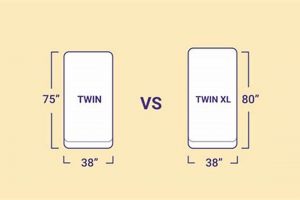
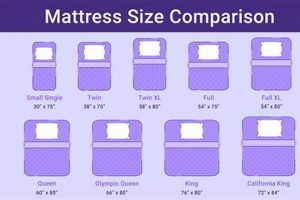
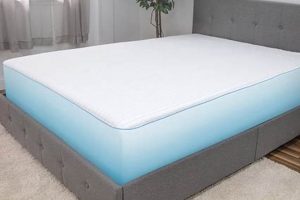
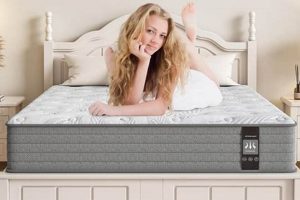
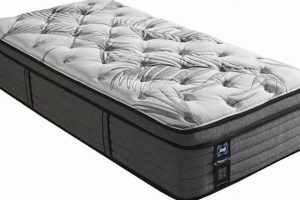
![Best Family XL Mattress [Deals!] for Comfy Sleep Organic & Natural Mattress Buyer’s Guide: Non-Toxic Sleep Solutions Best Family XL Mattress [Deals!] for Comfy Sleep | Organic & Natural Mattress Buyer’s Guide: Non-Toxic Sleep Solutions](https://mattressworldpa.com/wp-content/uploads/2025/07/th-847-300x200.jpg)